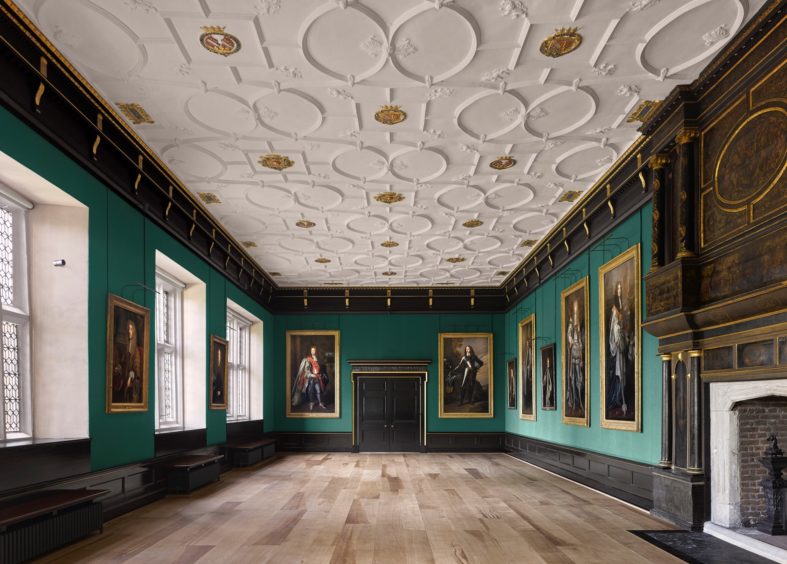The Charterhouse’s Great Chamber is Refurbished

The Charterhouse, the seven-acre historic site on the edge of the City of London, is delighted to announce the completion of the major refurbishment of the Great Chamber, the jewel in the crown of our Tudor history. Made possible with funding from The National Lottery Heritage Fund and our generous donors, the works started in January and have involved a host of artisan specialists under the direction of Richard Griffiths Architects who were awarded the commission.
The Lord Mayor of the City of London was kind enough to join us on 7th October for a private virtual launch, featuring talks from many of the key players involved, and offering the Master, Ann Kenrick, the opportunity to thank the donors, The Wolfson Foundation, the Linbury Trust, and the Schroder Foundation and all those who contributed to creating the grand new interior.
As the doors were opened to reveal the transformation, Alderman William Russell, the Rt Hon the Lord Mayor of the City of London said: “As a member of the Charterhouse’s Development Committee, I am very excited to see the success of this project in person. In my view it is one of the most splendid rooms in London, if not the country, and now this magnificent space has been restored to its former glory and fit for a queen once again. I hope, as I am sure we all hope, that visitors will be able to enjoy it and appreciate its majesty for themselves soon.”
In normal times we would be throwing open our doors to the public to discover the sumptuous changes in person but, as an almshouse charity, we need to stay closed during the pandemic until we can ensure the safety of our older and more vulnerable residents. In the meantime, we have created a virtual experience of the transformed Great Chamber on our website (linked below), where you can discover more about its history, the splendid collection of portraits now on display, and the detail of the refurbishment project.
The aim of the project was to create a more environmentally sustainable interior that also did better justice to the Chamber’s extraordinary history and splendour. The project will also ensure the Chamber’s suitability for an expanded range of ways it can be shared with the public. Our plans are of course on hold, but as soon as we can open again the intention is to attract new audiences to concerts, exhibitions, and other events to raise income for the Charterhouse charity – the almshouse originally established in 1611 and still flourishing today. The funding award will also go toward staffing and implementing an outreach programme aimed at introducing diverse audiences from the local community to the history of the Charterhouse and its purpose today. We have already initiated this Community Engagement programme, running creative online workshops, inspired by aspects of the Great Chamber and its portraits, with partners such as North London Cares, Age UK Islington, and BlindAid.
Project background
The Great Chamber represents an important example of London’s history, originally built by Edward North in the 1540s, and referred to as the ‘Throne Room’ after Elizabeth I held her first Privy Council there before being crowned Queen of England. The Chamber was the backdrop to decades of Tudor intrigue and plotting and remained the jewel in this grand Tudor Mansion until it suffered serious bomb damage during WW2. After the war a major project was initiated to renovate the room to match the one remaining undamaged section, and has been well used and much admired since.
Richard Griffiths Architects were selected, after a competitive tender process, to conceive and implement the redesign. A significant new development was the moving of the Charterhouse’s most notable portraits onto the walls of the Chamber, having been cleaned and renovated by conservator Jim Dimond.
The New Great Chamber
The new design references several different architectural schemes from different centuries. The colours from the fireplace and overmantel (dating from the 16th and 17th centuries) ar carried throughout the space and a green silk moiré provides the backdrop for our important collection of Restoration portraits. The floor has been replaced with boards of varying sizes and widths, referencing its post-Reformation origins.
The portraits of the Charterhouse
The works to be hung in the Great Chamber comprise large seventeenth century oil paintings of our Restoration era governors and include portraits of some of the periods most influential and controversial Royals, politicians and religious leaders. The pre-eminence of the sitters attests to the prominence of the Charterhouse during the period. They include portraits of the Duke of Monmouth, the Earl of Craven, the Duke of Buckingham, Gilbert Sheldon (Archbishop of Canterbury), Anthony Ashely Cooper – first Earl of Shaftesbury and Charles II.
The collection is mentioned in Vertue’s notebooks in 1736. The collection continued to be highly regarded and discussed in numerous documentary sources of the 18th and 19th centuries. In May 1941 the Charterhouse was bombed and the paintings were evacuated and did not return to London until 1957, by which time it seems that they had slipped from public and academic consciousness. Recent funding from the Paul Mellon Centre for Studies in British Art has enabled on-going research which has established the collection’s broader cultural and historic significance, both to the institution and wider fields of academic study.



